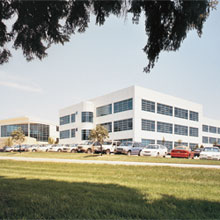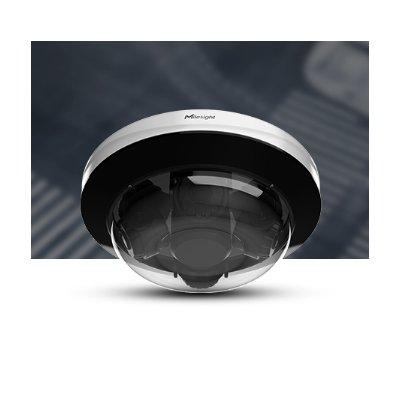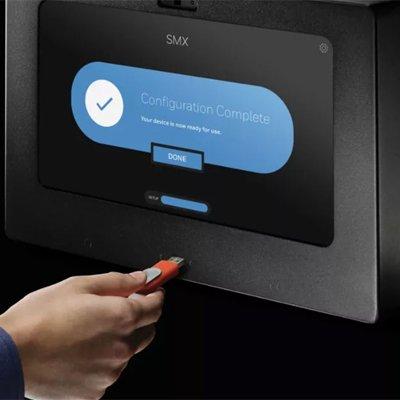 |
| The headquarters’ building security system integrates card access, intercom, and CCTV |
Security Benefit Group (SBG), a national financial services and retirement planning company, has earned a reputation as an innovator in its field while balancing associate needs with business demands. So it stood to reason that, in planning a new corporate headquarters in Topeka, Kansas, the company would integrate innovation into its quest to make associate comfort and satisfaction in the workplace its key objective.
“We believe associate comfort interacts closely with productivity,” says David Rutkowski, director of facilities and grounds with SBG. “If an associate is comfortable, if an associate is happy, then that person’s productivity will be high.” Johnson Controls partnered with SBG and its architect and contractors in a carefully coordinated design and construction process to deliver a building that embodies the company’s vision.
Working under an approach called Knowledge-Based Integration, Johnson Controls acted not just as a supplier but also as the project’s technology contractor, assisting the design and installation of building automation, comfort systems, access control and security systems, and communication networks.
Close working relationships among subcontractors and interaction with facility management personnel helped the building team hold down costs through construction efficiencies and long-term maintenance savings. The process also helped create an innovative, comfortable, energy-efficient workplace where more than 500 SBG associates can function at their best.
The 307,000-square-foot, $50 million SBG headquarters includes a Metasys® building management system that controls building comfort. Personal Environments® modules give associates customised control over comfort conditions in their own workstations.
“Knowledge-Based Integration is a powerful concept that helps companies create buildings that embody their key business objectives,” says Tim Swope, the Johnson Controls account executive for the SBG project. “It most certainly helped SBG maintain its long tradition of taking exceptional care of its associates.”
An early start on integration
SBG, in business since 1892, specialises in the sale and service of annuities, mutual funds, and qualified retirement plans for individuals and employer groups nationwide. It manages approximately $10 billion in assets and is regarded as a stable and significant employer in Topeka.
Ekdahl, Davis, Depew, Persson Architects designed the new headquarters; Latimer Sommers & Associates was the mechanical/electrical/plumbing engineer; general contractor was Ferrell Construction. Johnson Controls, as technology contractor, worked closely with those companies and with mechanical contractor McElroy’s, Inc., and electrical contractor Current Electric.
“We were very involved in the overall design,” says Johnson Controls’ Swope. “We knew the architect from previous projects and the owners from professional affiliations in Topeka. They brought us into the project extremely early. Once they chose to go with us for the Personal Environments and the building management system, we became an integral part of the design team.”
 |
| A CMMS resides on Johnson Contols’ Metasys system so that SBG personnel can manage maintenance efficiently |
In important ways, the Knowledge-Based Integration process revolved around SBG’s decision to install Personal Environments Modules – desktop control units from which associates can control their own individual settings for air temperature, air flow, radiant heat, lighting, and background noise masking. The system requires a change in traditional building design, delivering conditioned air through raised-floor plenums rather than ceiling ductwork.
Members of the SBG team visited Personal Environments module installation at the S.C. Johnson world headquarters in Racine, Wisconsin and liked what they saw.
“Personal Environments modules provide 100 percent ventilation effectiveness,” says Swope. “That means the building needs less chiller capacity, a smaller cooling coil, smaller pumps and smaller cooling towers. There is also no need for a central white noise generation system.” Despite an initial investment in the Personal Environments system, SBG found that reductions in other HVAC system costs and long term energy savings provided a simple payback that met its financial criteria. The Personal Environments serve a total of 763 work spaces in the building.
During design, the team saw potential immediate and long-term efficiencies in the raised floor. “We have all our data and voice cabling worked out in the raised floor,” Rutkowski says. “All the electrical is located there, and it’s plug and play. That allows for relatively quick changes in workstations. And of course the air-delivery system is through the floor. The Personal Environments modules pull air from that area, and we maintain a quality environment.”
Intelligent design decision making
Knowledge-Based Integration helped the project proceed without the turf battles, work confiicts, change orders, and delays often inherent in traditional hard-bid building projects, recalls Swope.
“It all came down to the owner wanting a quality building and choosing quality contractors,” says Swope. “SBG essentially told everyone to create a good building, and everyone worked toward that goal. We all functioned as a team. The design meetings fostered cooperation. Where project components crossed over different subcontractors’ areas, everybody asked, ‘How can we help?’ and tried to work out the details.”
A case in point: Because the parties cooperated, the building uses the same local area network (LAN) for the security and building management systems, an immediate savings on installation and a long-term maintenance-cost reduction. Current Electric facilitated that network’s installation, placing a complex series of conduits into the concrete floors while installing the electrical system.
As part of the integration process, SBG decided to add a measure of protection for its critical business data by placing it on its own network, separate from the security and building control network.
“Knowledge-Based Integration is a powerful concept that helps companies create buildings that embody their key business objectives” |
Rutkowski recalls another case in which design integration saved significant dollars. “At one of our weekly design meetings, (mechanical engineer) Jim Latimer and I saw a problem with the location of the cooling towers,” Rutkowski said. “The original plan was to place them toward the front of the building with sumps directly underneath. But the structural engineer noticed that the proposed location would lead to some major expenses.
“Jim and I took a notepad and drew out some sketches. Now all of sudden the cooling towers were up on the roof with fiberglass sumps located inside a penthouse area. The problem was resolved, and we had eliminated a couple hundred thousand dollars of structural work from the project.
“At moments like that, Johnson Controls supported us. As we came up with ideas, Tim Swope would be there offering particulars on where we could save money and letting us know if a given item was going to cause a headache, like high upkeep or costly maintenance later on. We had good rapport, based on the knowledge and experience we all had. We were on the same wavelength about what needed to be in the building to keep costs down and keep our associates comfortable.”
Integrating building support services
The building’s utilities and the HVAC systems benefited significantly from integration. For example:
- The Metasys building management system integrates with a chiller management program, enabling facilities staff to regulate and collect data on the functions of two 490-ton chillers through a single central operator workstation. The Metasys system also integrates control of variable-speed drives for the building’s air handlers and chilledwater and hot-water pumps.
- The building management system interfaces with the building’s power management system. This enables SBG personnel to monitor power consumption patterns and run reports from the Metasys workstation instead of from a separate system.
- The Metasys system uses a communications bus to send instructions directly to individual addressable lighting breakers that turn lights on and off. “That was a major cost savings,” Swope says. “The traditional configuration uses a power panel and a low-voltage relay panel. We eliminated the relay and the hard wiring between the relay and the power panel.”
- A computerised maintenance management system (CMMS) resides on the Metasys system so that SBG personnel can easily get real-time maintenance data and manage maintenance efficiently.
"As we came up with ideas, Tim Swope would be there offering particulars on where we could save money"
The building security system integrates card access, intercom, and CCTV. Use of the intercoms, unauthorised use of the card access system, or the triggering of a burglar alarm prompts the nearest CCTV camera to focus on the affected area so that the security staff can see what is happening.
Project integration also benefited the Federal Home Loan Bank, which occupies a three-floor pavilion in the building. SBG planned for the bank’s presence from the start.
“The bank has what is essentially its own separate facility, yet it is connected to all the control and support infrastructure in the SBG building,” Swope says. To improve comfort control in select spaces, which receive high solar load through the largely glass exterior, the bank has installed wireless thermostats for the variable air volume (VAV) controllers that communicate with the Metasys system. Wireless capability helps bank personnel easily place thermostats in the optimum locations.
The best way to build
SBG moved into its new headquarters in April 2002 after a 20-month construction process. Rutkowski reports that the company is well satisfied with the building and with the integrated design process.
“Having a construction background,” Rutkowski said. “I have seen the design-build process and I have seen other options. From my perspective, for creating a building that provides associate comfort with reduced upkeep and maintenance costs, there is no substitute for a process that allows all the engineers and contractors to bring their expertise together and come up with best design.”
“It also pays to bring in the facility people who are going to operate and maintain the building – to involve them from day one. They know the occupants and their needs better than anyone. It’s a natural fit. I don’t understand how a building could be built any other way,” Rutkowski concludes.
















